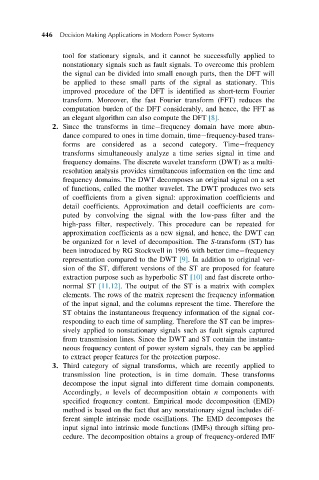Page 486 - Decision Making Applications in Modern Power Systems
P. 486
446 Decision Making Applications in Modern Power Systems
tool for stationary signals, and it cannot be successfully applied to
nonstationary signals such as fault signals. To overcome this problem
the signal can be divided into small enough parts, then the DFT will
be applied to these small parts of the signal as stationary. This
improved procedure of the DFT is identified as short-term Fourier
transform. Moreover, the fast Fourier transform (FFT) reduces the
computation burden of the DFT considerably, and hence, the FFT as
an elegant algorithm can also compute the DFT [8].
2. Since the transforms in time frequency domain have more abun-
dance compared to ones in time domain, time frequency-based trans-
forms are considered as a second category. Time frequency
transforms simultaneously analyze a time series signal in time and
frequency domains. The discrete wavelet transform (DWT) as a multi-
resolution analysis provides simultaneous information on the time and
frequency domains. The DWT decomposes an original signal on a set
of functions, called the mother wavelet. The DWT produces two sets
of coefficients from a given signal: approximation coefficients and
detail coefficients. Approximation and detail coefficients are com-
puted by convolving the signal with the low-pass filter and the
high-pass filter, respectively. This procedure can be repeated for
approximation coefficients as a new signal, and hence, the DWT can
be organized for n level of decomposition. The S-transform (ST) has
been introduced by RG Stockwell in 1996 with better time frequency
representation compared to the DWT [9]. In addition to original ver-
sion of the ST, different versions of the ST are proposed for feature
extraction purpose such as hyperbolic ST [10] and fast discrete ortho-
normal ST [11,12]. The output of the ST is a matrix with complex
elements. The rows of the matrix represent the frequency information
of the input signal, and the columns represent the time. Therefore the
ST obtains the instantaneous frequency information of the signal cor-
responding to each time of sampling. Therefore the ST can be impres-
sively applied to nonstationary signals such as fault signals captured
from transmission lines. Since the DWT and ST contain the instanta-
neous frequency content of power system signals, they can be applied
to extract proper features for the protection purpose.
3. Third category of signal transforms, which are recently applied to
transmission line protection, is in time domain. These transforms
decompose the input signal into different time domain components.
Accordingly, n levels of decomposition obtain n components with
specified frequency content. Empirical mode decomposition (EMD)
method is based on the fact that any nonstationary signal includes dif-
ferent simple intrinsic mode oscillations. The EMD decomposes the
input signal into intrinsic mode functions (IMFs) through sifting pro-
cedure. The decomposition obtains a group of frequency-ordered IMF

